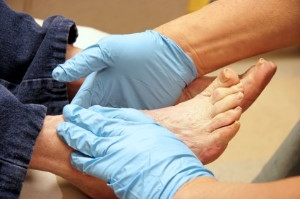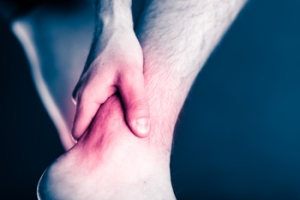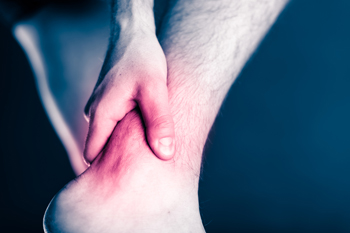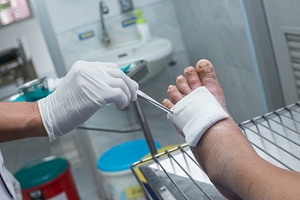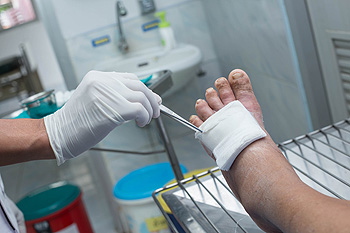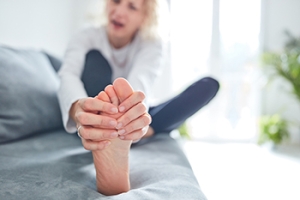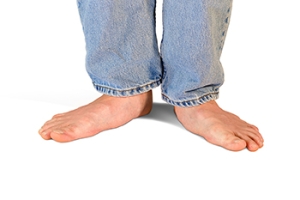
Foot Care Tips for Diabetic Patients
 Because of the potential loss of feeling in the feet, diabetic patients must be mindful of their everyday foot health in order to avoid more serious issues. First, diabetic patients should check their feet daily for any cuts, blisters, nail problems, or wounds in general. Second, they should moisturize their feet regularly to prevent cracking. Lastly, they should schedule regular check-ups with a podiatrist for a foot exam to prevent further complications. In fact, regular checkups with a podiatrist can reduce the risk of amputation from anywhere between 45 and 85 percent. There are also a few things diabetic patients should avoid in order to take care of their feet. Heating pads and electric blankets shouldn’t be used in order to prevent the feet from getting burned. They should also make sure to not remove any corns or calluses on their own, but instead consult with a podiatrist. If you are a diabetic patient and have issues with your feet, or you need a checkup, please schedule an appointment with a podiatrist.
Because of the potential loss of feeling in the feet, diabetic patients must be mindful of their everyday foot health in order to avoid more serious issues. First, diabetic patients should check their feet daily for any cuts, blisters, nail problems, or wounds in general. Second, they should moisturize their feet regularly to prevent cracking. Lastly, they should schedule regular check-ups with a podiatrist for a foot exam to prevent further complications. In fact, regular checkups with a podiatrist can reduce the risk of amputation from anywhere between 45 and 85 percent. There are also a few things diabetic patients should avoid in order to take care of their feet. Heating pads and electric blankets shouldn’t be used in order to prevent the feet from getting burned. They should also make sure to not remove any corns or calluses on their own, but instead consult with a podiatrist. If you are a diabetic patient and have issues with your feet, or you need a checkup, please schedule an appointment with a podiatrist.
Diabetic foot care is important in preventing foot ailments such as ulcers. If you are suffering from diabetes or have any other concerns about your feet, contact Milos Tomich, DPM from Dr. Tomich Foot & Ankle Health Center. Our doctor can provide the care you need to keep you pain-free and on your feet.
Diabetic Foot Care
Diabetes affects millions of people every year. The condition can damage blood vessels in many parts of the body, especially the feet. Because of this, taking care of your feet is essential if you have diabetes, and having a podiatrist help monitor your foot health is highly recommended.
The Importance of Caring for Your Feet
- Routinely inspect your feet for bruises or sores.
- Wear socks that fit your feet comfortably.
- Wear comfortable shoes that provide adequate support.
Patients with diabetes should have their doctor monitor their blood levels, as blood sugar levels play such a huge role in diabetic care. Monitoring these levels on a regular basis is highly advised.
It is always best to inform your healthcare professional of any concerns you may have regarding your feet, especially for diabetic patients. Early treatment and routine foot examinations are keys to maintaining proper health, especially because severe complications can arise if proper treatment is not applied.
If you have any questions please feel free to contact one of our offices located in Milwaukee and Wauwatosa, WI . We offer the newest diagnostic and treatment technologies for all your foot and ankle needs.
Diabetic Foot Care
Diabetes can cause two problems that can potentially affect the feet: Diabetic neuropathy and Peripheral Vascular Disease. Diabetic neuropathy occurs when nerves in your legs and feet become damaged, which prevents you from feeling heat, cold, or pain. The problem with diabetic neuropathy is that a cut or sore on the foot may go unnoticed and the cut may eventually become infected. This condition is also a main cause of foot ulcers. Additionally, Peripheral vascular disease also affects blood flow in the body. Poor blood flow will cause sores and cuts to take longer to heal. Infections that don’t heal do to poor blood flow can potentially cause ulcers or gangrene.
There are certain foot problems that are more commonly found in people with diabetes such as Athlete’s foot, calluses, corns, blisters, bunions, foot ulcers, ingrown toenails, and plantar warts. These conditions can lead to infection and serious complications such as amputation. Fortunately, proper foot care can help prevent these foot problems before they progress into more serious complications.
Each day you should wash your feet in warm water with a mild soap. When you finish washing your feet, dry them carefully especially between your toes. You should also perform daily foot inspections to ensure you don’t have any redness, blisters, or calluses. Furthermore, if you are diabetic, you should always wear closed-toed shoes or slippers to protect your feet. Practicing these tips will help ensure that your feet are kept healthy and away from infection.
If you have diabetes, contact your podiatrist if you have any of the following symptoms on your feet: changes in skin color, corns or calluses, open sores that are slow to heal, unusual and persistent odor, or changes in skin temperature. Your podiatrist will do a thorough examination of your feet to help treat these problematic conditions.
Sudden Ankle Pain May Be Due to Arthritis
If you suddenly experience ankle pain without any apparent reason or injury, it may have been brought on by some form of arthritis. For instance, osteoarthritis occurs when cartilage between bones wears down, causing them to rub together. This condition can sometimes cause sudden pain, often in the morning. Another type of arthritis—rheumatoid arthritis—causes your immune system to malfunction and attack healthy tissue. The lining in joints of the toes and ankles are a common location for rheumatoid arthritis to develop. A third type of arthritis that can affect your ankles is reactive arthritis. This occurs when a bacterial infection in another part of the body is responsible for generating arthritic symptoms like swelling and pain in your ankles. Gout is an arthritic condition caused by a build-up of uric acid in your body, which can crystallize on joints. Although gout typically affects the big toe, it can also develop in other joints, such as the ankle. Painful gout flare-ups are known to be intense and sudden, often occurring in the middle of the night. Pain of any kind in your ankles should prompt a visit to the podiatrist as soon as possible for an accurate diagnosis and treatment.
Ankle pain can have many different causes and the pain may potentially be serious. If you have ankle pain, consult with Milos Tomich, DPM from Dr. Tomich Foot & Ankle Health Center. Our doctor will assess your condition and provide you with quality foot and ankle treatment.
Ankle pain is any condition that causes pain in the ankle. Due to the fact that the ankle consists of tendons, muscles, bones, and ligaments, ankle pain can come from a number of different conditions.
Causes
The most common causes of ankle pain include:
- Types of arthritis (rheumatoid, osteoarthritis, and gout)
- Ankle sprains
- Broken ankles
- Achilles tendinitis
- Achilles tendon rupture
- Stress fractures
- Tarsal tunnel syndrome
- Plantar fasciitis
Symptoms
Symptoms of ankle injury vary based upon the condition. Pain may include general pain and discomfort, swelling, aching, redness, bruising, burning or stabbing sensations, and/or loss of sensation.
Diagnosis
Due to the wide variety of potential causes of ankle pain, podiatrists will utilize a number of different methods to properly diagnose ankle pain. This can include asking for personal and family medical histories and of any recent injuries. Further diagnosis may include sensation tests, a physical examination, and potentially x-rays or other imaging tests.
Treatment
Just as the range of causes varies widely, so do treatments. Some more common treatments are rest, ice packs, keeping pressure off the foot, orthotics and braces, medication for inflammation and pain, and surgery.
If you have any questions, please feel free to contact one of our offices located in Milwaukee and Wauwatosa, WI . We offer the newest diagnostic and treatment technologies for all your foot care needs.
Ankle Pain
The ankle joint is the point at which the bones of the leg and foot join. This joint is crucial because it is responsible for the foot’s mobility. Ankle pain is typically the result of inflammation from an injury to bones, joint space, cartilage, ligaments, tendons, or muscles in the area. Commonly associated symptoms with ankle pain are bruising, redness, numbness, stiffness, weakness, and tingling.
The most common causes of ankle pain are sprains and injuries. Ankle sprains are one of the most common musculoskeletal injuries. Sprains occur when the ligaments of the ankle become partially or completely torn due to sudden stretching. Sprains can occur on either the inner or outer sides of the ankle joint. Usually, these injuries occur when the ankle is twisted in an activity by stepping off an uneven surface. More specific causes include rheumatoid arthritis, gout, osteoarthritis, and Achilles tendonitis.
If you are experiencing ankle pain, you should consult with your podiatrist to choose the best method of care. Your doctor will conduct an examination of your ankle to determine the underlying cause of the pain.
Different Types of Diabetic Foot Ulcers
Diabetic foot ulcers are slow healing wounds that appear on the feet of individuals with diabetes and can become a very serious health issue. Almost a quarter of all individuals diagnosed with diabetes will develop a foot ulcer at some point in their life. There are several types of diabetic foot ulcers, and knowing which type you have can help determine the most effective treatment. Neuropathic ulcers occur when nerve damage from diabetic neuropathy prevents the patient with diabetes from feeling pain from an injury. This allows the wound to progress before you are even aware of it, increasing the risk of infection. Ischemic ulcers may be caused by a lack of blood flow to the feet. These types of ulcers are often difficult to heal. Neuroischemic ulcers are the most difficult to heal and occur in individuals who have both neuropathy and poor circulation. Infected wounds occur in half of diabetic patients with foot ulcers, and require close medical attention. If you have diabetic foot ulcers, it is highly recommended that you are under the care of a podiatrist who can help you look after your wounds and prevent severe complications.
Wound care is an important part in dealing with diabetes. If you have diabetes and a foot wound or would like more information about wound care for diabetics, consult with Milos Tomich, DPM from Dr. Tomich Foot & Ankle Health Center. Our doctor will assess your condition and provide you with quality foot and ankle treatment.
What Is Wound Care?
Wound care is the practice of taking proper care of a wound. This can range from the smallest to the largest of wounds. While everyone can benefit from proper wound care, it is much more important for diabetics. Diabetics often suffer from poor blood circulation which causes wounds to heal much slower than they would in a non-diabetic.
What Is the Importance of Wound Care?
While it may not seem apparent with small ulcers on the foot, for diabetics, any size ulcer can become infected. Diabetics often also suffer from neuropathy, or nerve loss. This means they might not even feel when they have an ulcer on their foot. If the wound becomes severely infected, amputation may be necessary. Therefore, it is of the upmost importance to properly care for any and all foot wounds.
How to Care for Wounds
The best way to care for foot wounds is to prevent them. For diabetics, this means daily inspections of the feet for any signs of abnormalities or ulcers. It is also recommended to see a podiatrist several times a year for a foot inspection. If you do have an ulcer, run the wound under water to clear dirt from the wound; then apply antibiotic ointment to the wound and cover with a bandage. Bandages should be changed daily and keeping pressure off the wound is smart. It is advised to see a podiatrist, who can keep an eye on it.
If you have any questions, please feel free to contact one of our offices located in Milwaukee and Wauwatosa, WI . We offer the newest diagnostic and treatment technologies for all your foot care needs.
Wound Care
Diabetics must be wary of all wounds, regardless of depth or size. Diabetes, a chronic disease in which the body cannot properly use glucose the way it normally would, causes various complications that make wounds difficult to heal. Nerve damage or neuropathy will cause diabetics to have trouble feeling the pain of a blister or cut until the condition has significantly worsened or become infected. A diabetic’s weakened immune system can make even the most minor of wounds easily susceptible to infection. Diabetics are also more prone to developing narrow, clogged arteries, and are therefore more likely to develop wounds.
Wounds should be taken care of immediately after discovery, as even the smallest of wounds can become infected if enough bacteria build up within the wound. To remove dirt, wounds should be first rinsed under running water only. Soap, hydrogen peroxide, or iodine can irritate the injury and should be avoided. To prevent infection, apply antibiotic ointment to the wound and cover it with a bandage. The bandage should be changed daily. The skin around the wound may be cleaned with soap.
To prevent further exacerbation, see a doctor—especially if you have diabetes. Minor skin conditions can become larger problems if not properly inspected. As the wound heals, make sure to avoid applying pressure to the affected area.
Common Reasons Foot Pain May Occur
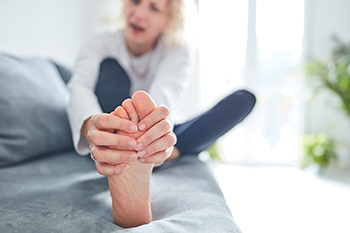 There are several reasons why many different people can experience foot pain at some point in their lives. These can include being obese, diabetic, or pregnant. Additional medical conditions such as gout and different forms of arthritis may also lead to foot pain. Standing or walking on hard surfaces for the majority of the day may be another source of foot pain. Many people wear shoes that do not fit correctly, and this may be one of the most common reasons why chronic foot pain can occur. If you have foot pain for any reason, it is strongly suggested that you consult with a podiatrist as quickly as possible who can effectively diagnose and treat your cause of foot pain.
There are several reasons why many different people can experience foot pain at some point in their lives. These can include being obese, diabetic, or pregnant. Additional medical conditions such as gout and different forms of arthritis may also lead to foot pain. Standing or walking on hard surfaces for the majority of the day may be another source of foot pain. Many people wear shoes that do not fit correctly, and this may be one of the most common reasons why chronic foot pain can occur. If you have foot pain for any reason, it is strongly suggested that you consult with a podiatrist as quickly as possible who can effectively diagnose and treat your cause of foot pain.
Foot Pain
Foot pain can be extremely painful and debilitating. If you have a foot pain, consult with Milos Tomich, DPM from Dr. Tomich Foot & Ankle Health Center. Our doctor will assess your condition and provide you with quality foot and ankle treatment.
Causes
Foot pain is a very broad condition that could be caused by one or more ailments. The most common include:
- Bunions
- Hammertoes
- Plantar Fasciitis
- Bone Spurs
- Corns
- Tarsal Tunnel Syndrome
- Ingrown Toenails
- Arthritis (such as Gout, Rheumatoid, and Osteoarthritis)
- Flat Feet
- Injury (from stress fractures, broken toe, foot, ankle, Achilles tendon ruptures, and sprains)
- And more
Diagnosis
To figure out the cause of foot pain, podiatrists utilize several different methods. This can range from simple visual inspections and sensation tests to X-rays and MRI scans. Prior medical history, family medical history, and any recent physical traumatic events will all be taken into consideration for a proper diagnosis.
Treatment
Treatment depends upon the cause of the foot pain. Whether it is resting, staying off the foot, or having surgery; podiatrists have a number of treatment options available for foot pain.
If you have any questions, please feel free to contact one of our offices located in Milwaukee and Wauwatosa, WI . We offer the newest diagnostic and treatment technologies for all your foot care needs.
Foot Pain
The feet, being the foundation of the body, carry all of the body’s weight and are therefore prone to experiencing pain and discomfort. If you are experiencing foot pain, it is important to determine where in the foot you are experiencing this pain to help discover the cause of it. While pain can be experienced virtually anywhere in the foot, the most common sites of foot pain are in the heel and ankle.
Heel pain can be due to a multitude of conditions including plantar fasciitis, Achilles tendinitis, and heel spurs. Pain experienced in the ankle can be a sign of an ankle sprain, arthritis, gout, ankle instability, ankle fracture, or nerve compression. In more serious cases, pain in the foot can be a sign of improper alignment or an infection.
Foot pain can be accompanied by symptoms including redness, swelling, stiffness and warmth in the affected area. Whether the pain can be described as sharp or dull depends on the foot condition behind it. It is important to visit your local podiatrist if your foot pain and its accompanying symptoms persist and do not improve over time.
Depending on the location and condition of your foot pain, your podiatrist may prescribe certain treatments. These treatments can include but are not limited to prescription or over-the-counter drugs and medications, certain therapies, cortisone injections, or surgery.
If you are experiencing persistent foot pain, it is important to consult with your foot and ankle doctor to determine the cause and location. He or she will then prescribe the best treatment for you. While milder cases of foot pain may respond well to rest and at-home treatments, more serious cases may take some time to fully recover.
Stretching and Flat Feet
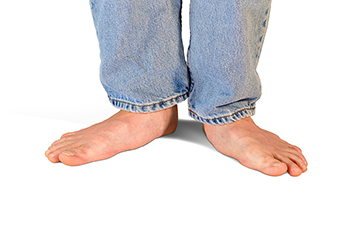 Many patients with flat feet have found that frequently performing specific exercises may help their feet feel better. The pain from this condition is normally felt in the bottom of the foot, and it can make accomplishing daily activities difficult to complete. Flat feet, or fallen arches, can be a result of overstretched tissues which may lead to additional foot conditions. Stretching the heel can help the entire foot. This can be done by standing with your hands resting against a wall. As one leg is extended behind you, a gentle stretch can be felt in the Achilles tendon when the body is pushed toward the wall. Research has indicated that rolling the heel on a tennis ball can also help to strengthen the arch. If you have flat feet, please speak with a podiatrist to learn about what exercises and stretches may help your condition.
Many patients with flat feet have found that frequently performing specific exercises may help their feet feel better. The pain from this condition is normally felt in the bottom of the foot, and it can make accomplishing daily activities difficult to complete. Flat feet, or fallen arches, can be a result of overstretched tissues which may lead to additional foot conditions. Stretching the heel can help the entire foot. This can be done by standing with your hands resting against a wall. As one leg is extended behind you, a gentle stretch can be felt in the Achilles tendon when the body is pushed toward the wall. Research has indicated that rolling the heel on a tennis ball can also help to strengthen the arch. If you have flat feet, please speak with a podiatrist to learn about what exercises and stretches may help your condition.
Flatfoot is a condition many people suffer from. If you have flat feet, contact Milos Tomich, DPM from Dr. Tomich Foot & Ankle Health Center. Our doctor will treat your foot and ankle needs.
What Are Flat Feet?
Flatfoot is a condition in which the arch of the foot is depressed and the sole of the foot is almost completely in contact with the ground. About 20-30% of the population generally has flat feet because their arches never formed during growth.
Conditions & Problems:
Having flat feet makes it difficult to run or walk because of the stress placed on the ankles.
Alignment – The general alignment of your legs can be disrupted, because the ankles move inward which can cause major discomfort.
Knees – If you have complications with your knees, flat feet can be a contributor to arthritis in that area.
Symptoms
- Pain around the heel or arch area
- Trouble standing on the tip toe
- Swelling around the inside of the ankle
- Flat look to one or both feet
- Having your shoes feel uneven when worn
Treatment
If you are experiencing pain and stress on the foot you may weaken the posterior tibial tendon, which runs around the inside of the ankle.
If you have any questions please feel free to contact one of our offices located in Milwaukee and Wauwatosa, WI . We offer the newest diagnostic and treatment technologies for all your foot and ankle needs.
What is Flexible Flat Foot?
Flatfoot is classified as having the entire sole of the foot in contact or near contact to the ground while standing. The disorder is also known as fallen arches, because those affected have no arch in their feet. Flexible flatfoot and rigid flatfoot are the two types of flatfoot.
A person has flexible flatfoot if when sitting or standing on their toes, they have an arch that disappears when they stand with the entire foot on the ground. Flexible flatfoot may also be called “pediatric flatfoot” because the condition first appears in childhood. It is common among infants because the arch does not develop until the age of 5 or 6 years. Rigid flatfoot is not as common in children as it is with adults. This type of flatfoot is developed due to the weakening of tibialis posterior muscle tendon, a major supporting structure of the foot arch. Development of this deformity is progressive and shows early signs of pain and swelling that begins at the inside arch of the foot and moves to the outside of the foot below the ankle. More severe cases can possibly lead to arthritis of the foot and ankle joints.
Although most cases of flatfoot involve people born with the condition, some less common causes are obesity, diabetes, pregnancy, and osteoporosis. In some cases, flatfoot may come with no symptoms at all and does not require any type of treatment. With other cases though, symptoms may include pain in the shin, knee, hips and lower back. If a person with flatfeet experiences such symptoms, a health care provider may suggest using orthotic devices or arch supports, which may reduce the pain. Wearing supportive shoes can also prove more comfortable with flatfeet and staying away from shoes with little support such as sandals. Other methods to relieve pain also include stretching the Achilles tendon properly and using proper form when doing any physical activity. In addition, losing weight can reduce the stress on your feet and reduce the pain.

